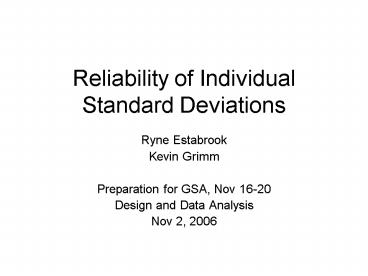Reliability of Individual Standard Deviations PowerPoint PPT Presentation
1 / 16
Title: Reliability of Individual Standard Deviations
1
Reliability of Individual Standard Deviations
- Ryne Estabrook
- Kevin Grimm
- Preparation for GSA, Nov 16-20
- Design and Data Analysis
- Nov 2, 2006
2
Individual Standard Deviations
- Measure of intraindividual variability.
- Scaled in the units of the measure.
- Easily calculable and interpretable.
- Measures of intraindividual variability are
useful both as outcomes and predictors. - Used in cases where meaningful interoccasion
variability exists, but shows no discernable
trend.
3
Problems with ISDs
- ISDs are treated as theoretically identical to
means, and differences between them are not
checked. - Classical test theory violations
- ISDs assume meaningful true score variance.
- CTT assumes all variance is error variance.
- Means and ISDs may be differentially reliable.
- ISDs may require more occasions to be reliable
than means do.
4
Objectives of the Simulation
- To explore how true-score variance affects
reliability, simulations were carried out. - Discern the requisite number of occasions and
reliability of the original test to produce valid
ISDs. - Discover the variance conditions under which ISDs
are most reliable, and allow researchers to
estimate reliability.
5
Setting Up the Simulation
- For each iteration
- A sample of 100 records are assigned both a mean
and an ISD from a bivariate normal distribution. - Means are distributed in the population N(0,k).
- ISDs are distributed in the population N(f(k),
g(k)) such that f(k) and g(k) vary across
iterations. - µISD 0.5-5.0 sMEAN, sISD .25-2.5
sMEAN - µISD3sISD to keep the distribution of ISDs above
zero. - Alterations to the ranges of the above parameters
did not significantly alter results.
6
Setting Up the Simulation
- For each iteration
- A number of observations (t) and test reliability
(?) were assigned. - t within 3103, ? within .09.99
- Each record is observed t times, with an observed
score at every occasion calculated from µj and
sj. - Observed Scoreij v? Trueij v(1-?) Errorij
- An observed mean and ISD is calculated for each
record. - Each dataset thus included 100 records for each
possible combination of µISD, sISD,t and ?. - The procedure was repeated for 75 datasets.
7
First Simulation
- Investigate the reliability of across occasion
means. - Correlation between true and observed means
constitutes the reliability index. - Regress reliability of the across occasion mean
on the µISD, sISD, number of occasions and
?MEASURE. - Stepwise regression of the parameters, their
transformations and 2-way interactions yielded an
average R2 of .936.
8
Results - Mean
µISD .5 sMEAN
µISD sMEAN
µISD 1.5 sMEAN
9
Results - Mean
- Inclusion of intraindividual variation
- Increasing µISD negatively affects reliability.
- Increasing sISD has a negligble negative affect
on reliability. - May result from a non-linear effect of µISD and
the correlation between µISD and sISD . - Highlights the CTT issue
- Any increase in variance is treated as error
variance, decreasing the estimated reliability.
10
Results - Mean
- Increasing the number of observations provides
the greatest benefit to reliability. - Reliability of the original measure has little
effect relative to other predictors. - Multiple iterations of identical tests serve to
increase the test length by a factor of t. - Test reliability indicates the within occasion
maximum for reliable measurement aggregating
increases reliability very quickly.
11
Second Simulation
- Investigate the reliability of across occasion
individual standard deviations. - Correlation between true and observed ISDs
constitutes the reliability index. - Regress reliability of the ISD on the µISD, sISD,
number of occasions and ?MEASURE. - Stepwise regression of the parameters, their
transformations and 2-way interactions yielded an
average R2 of .955.
12
Results - ISD
13
Results - ISD
- Increasing the ratio of sISD to µISD increases
reliability. - Increasing sISD and µISD in proportion changes
the units, but not the meaning, of ISDs. - The number of occasions has a greater effect for
ISDs than for means. - The reliability of the measure used again has a
negligible effect.
14
Conclusions
- Reliability of means and ISDs depend on the
relationship between µISD, sISD sMEAN. - Means are most reliable when variance (µISD or
error) is minimized. - ISDs are most reliable when sISD is maximized
relative to µISD and, to a lesser extent, sMEAN. - ISDs are less reliable than means.
- ISDs based on very few occasions may be too
unreliable to interpret.
15
Implications
- Tests that are reliable for mean levels may not
be reliable for measuring variability. - ISDs from few occasions lack statistical power.
- ISDs do not differ theoretically from
single-occasion population standard deviations. - Standard deviations based on 10 observations of
an individual are as reliable as a standard
deviation from a sample of 10.
16
Thanks
- John Nesselroade
- Current and former colleagues at CDHRM at the
University of Virginia - NIA T32 AG20500-01

